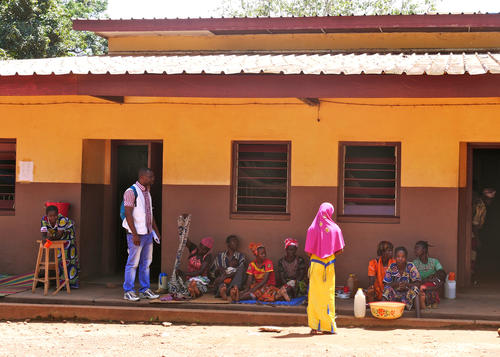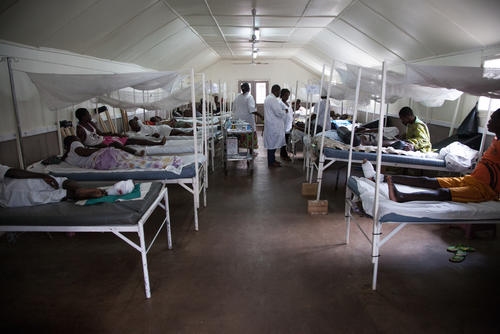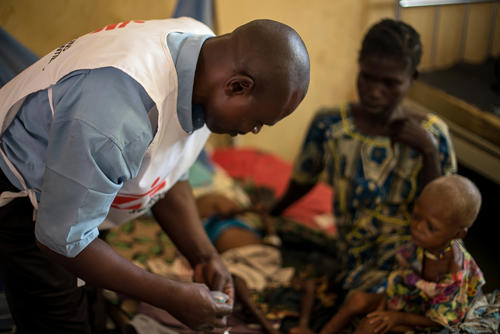For over 18 months, Central African Republic (CAR) has yet again been subjected to extreme violence inflicted on a population left traumatised by the civil war in 2013 and 2014. Until recently, the capital city Bangui appeared to have been spared the attacks and fighting that have erupted in the provinces.
This is no longer the case. In just a few weeks, over 150 casualties have been treated in SICA hospital managed by Médecins Sans Frontières in Bangui. The teams have had to activate two mass casualty plans to respond to the emergency caused by a succession of particularly violent days in the capital.

Mass Casualty Plan in Bangui
On Sunday 8 April, national and international security forces mounted a joint operation against local armed groups in the city’s economic hub and mainly Muslim PK5 district. The operation led to clashes that left dozens of wounded among the armed forces as well as the population.
Two days later, the fighting flared up again and casualties arrived in huge numbers at the city’s medical facilities. Over the course of two days, the teams in SICA hospital treated 64 patients, principally for bullet wounds.
Violence erupted yet again on Tuesday, 1 May, with clashes and attacks targeting Fatima district, especially the church, as well as PK5 and the surrounding neighbourhoods. Armed groups, but also people who live in these neighbourhoods, clashed and heavy artillery resounded throughout the town.
This resurgence of violence, unprecedented since 2015, has rekindled divisions between Christian and Muslim communities and triggered a wave of reprisals across the city. It’s challenging for people, and therefore medical teams and ambulances, to move around, homes and places of worship have been torched and vandalised, and families have been forced to leave their homes. Over 70 casualties were treated in SICA hospital in just a few hours on 1 May, prompting MSF’s teams to activate the mass casualty plan for a second time.
The mass casualty plan is activated to respond to a mass influx of casualties during emergency situations. A triage zone is set up at the hospital entrance where medical personnel determine the severity of patients’ injuries and assign them a colour. “Green” patients are the least severely wounded. Once they’re examined, some are fitted with plaster casts and others have their wounds dressed or are referred for X-rays and told to come back for further treatment in a few days. “Yellow” patients require more complex care in the emergency room and “red” patients are often taken straight to the operating theatre. “Black” patients are in such critical condition that they are either deceased on arrival, die very soon after, or have very little chance of survival.
For the logistics teams, the challenge is to set up as soon as the plan is activated a system to admit and initiate care of wounded patients, while ensuring a minimum level of security.
“Our priority was organising a triage zone, positioning beds and stretchers and setting up an area in front of the hospital where the wounded could come in and out and the porters and medical staff could work without being hampered by the crowds of people,” explains Pierre, a logistician at SICA hospital. “The guards are really important. They talk to people, try and calm things down and explain what MSF does.”
On 1 May, the crowd set upon an ambulance they thought was transporting wounded Muslims to SICA hospital. It did eventually manage to get through. The casualties — men and women but also children — arrived in waves.
“The patients we treated on the days we activated the mass casualty plan had war wounds,” adds orthopaedic surgeon André Valembrun. “These cause significant damage to bones and tissue that often require long and complicated treatment.”
Pascale is a nurse. She’d gone to Bangui for an entirely different purpose: assisting with the long-term introduction of osteosynthesis in surgical care at SICA hospital. The emergency rapidly took priority over her work schedule as, during mass casualty plans, all available medical personnel are called in to help. Pascale looked after patients in the “green” zone. While undoubtedly less serious, “green” doesn’t mean patients’ injuries are trivial and Pascale saw people with fractures, open wounds or grenade shrapnel in their faces.
“One of the patients who affected me most was a woman who had no idea where she was. I later found out her child had been shot and taken to another of the city’s medical facilities,” Pascale said. “She jumped on a motorbike taxi to go to him but in the general panic, with crowds of people trying to flee the fighting, she had an accident. She was injured and brought to SICA hospital. She was completely out of it so I stayed with her until she gradually came round. Lots of the patients were in a state of shock. They hadn’t expected such a level of violence.”
After the shockwave, an uneasy calm has returned to Bangui. Like some of his Central African colleagues, Pierre wants to believe the worst-case scenario is still preventable.
“There’s an atmosphere stoking preparations for violence. There’s a lot of uncertainty and rumours are rife,” said Pierre “The accumulation of tensions could unleash a huge wave of violence. But people here are all too familiar with mindless violence and, although the fear is really palpable, there’s also a sense that the worst isn’t inevitable.”





